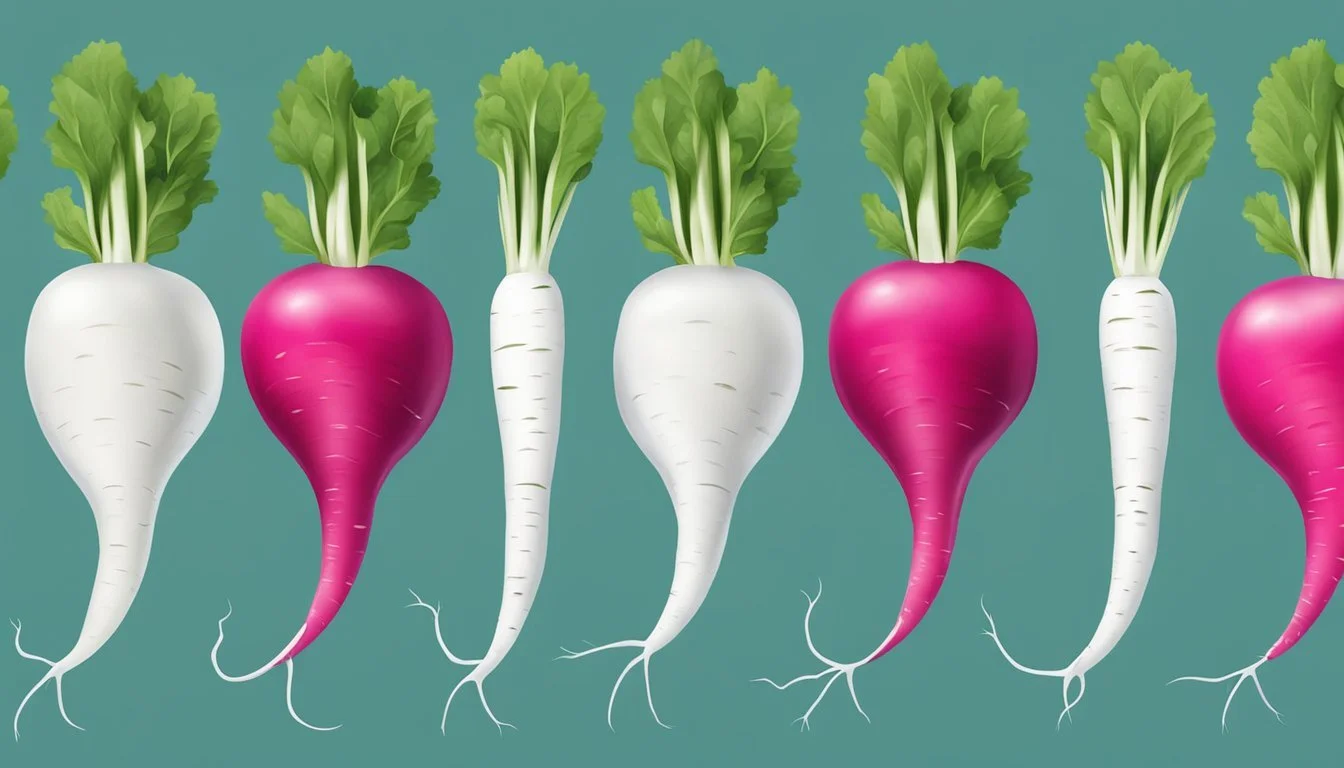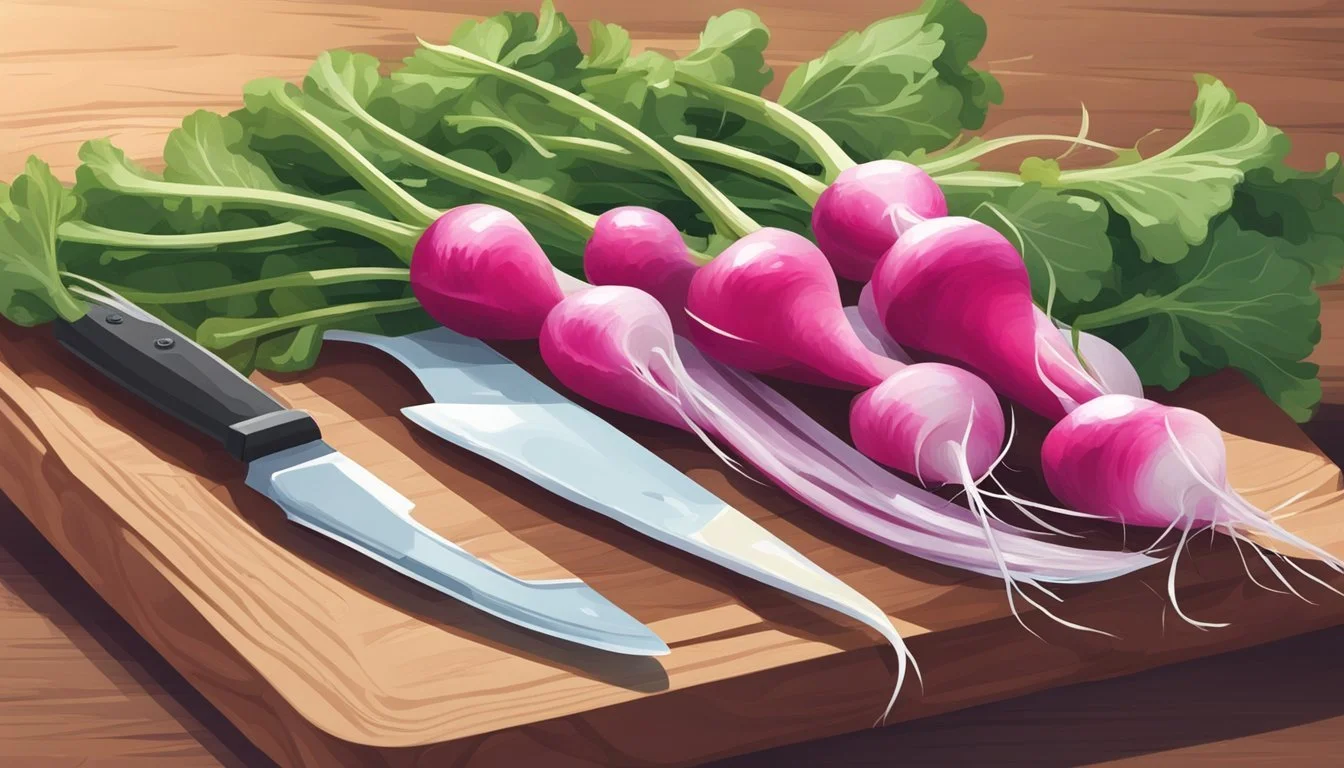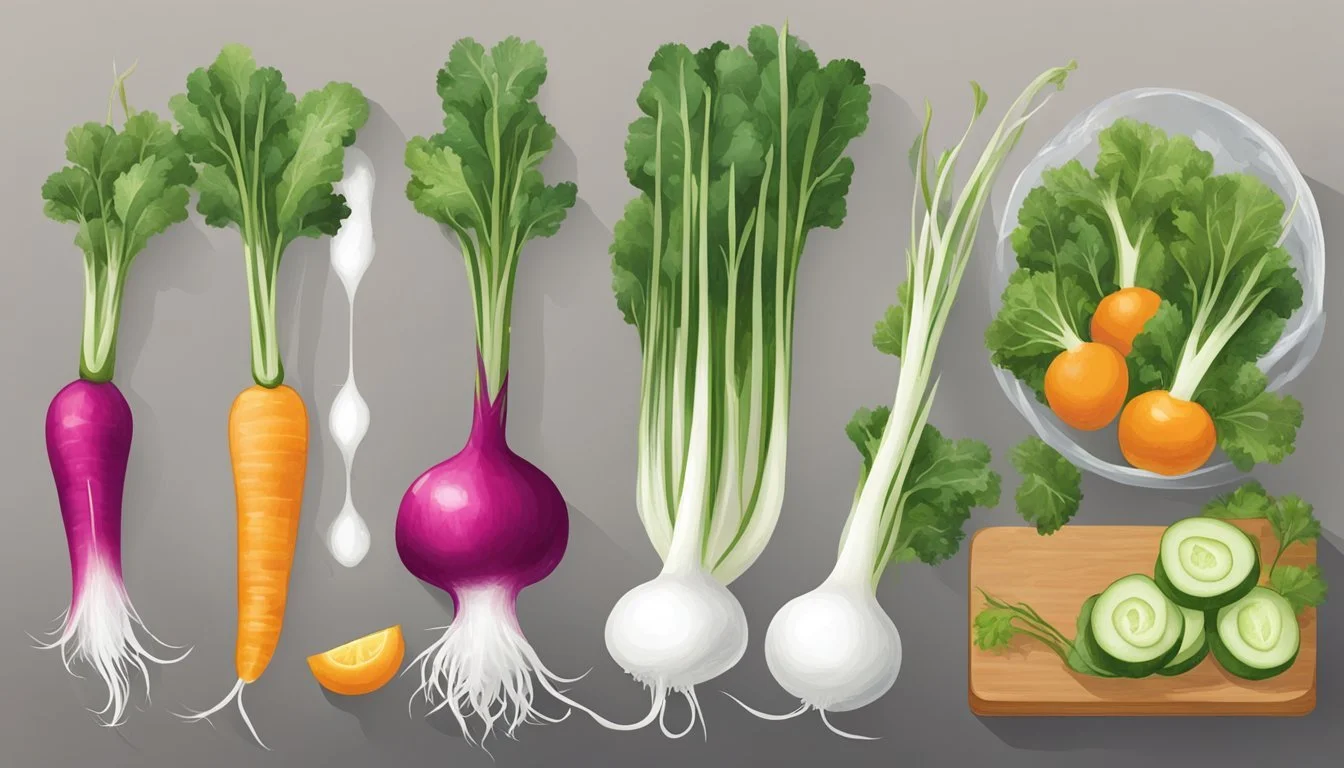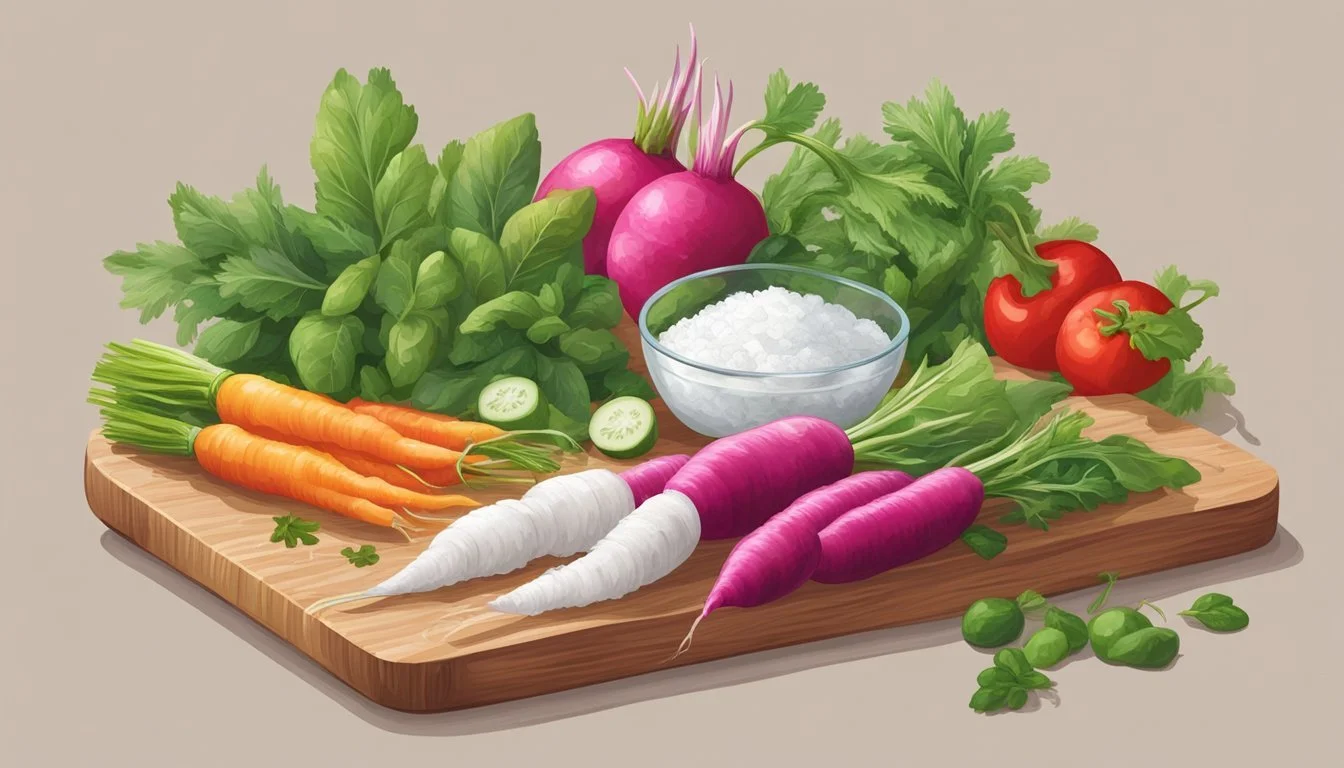Icicle Radish Substitutes
Best Alternatives for Your Recipes
Looking for a substitute for Icicle radish in your favorite recipes? You've come to the right place. Icicle radishes are known for their crisp texture and mildly spicy flavor, making them a versatile ingredient in salads, stir-fries, and more. When you need a replacement, it's essential to find a root vegetable that offers similar benefits and flavors.
Parsnips provide a great alternative to Icicle radishes, especially when cooked. Their creamy color, comparable shape, and sweet flavor make them ideal for soups, stews, and roasted dishes. Another excellent choice is jicama, a Mexican root vegetable known for its crunchy texture and slightly sweet taste, perfect for adding a refreshing element to your salads.
To add a pop of color and a bit of heat, radishes like Cherry Belle or White Icicle can also stand in for Icicle radishes. They can be eaten raw, cooked, or pickled, offering a variety of options for your culinary creations. Experimenting with these substitutes can not only maintain the integrity of your dishes but also introduce you to new flavors and textures.
Understanding Icicle Radish
Icicle radishes are known for their mild, crunchy texture, and sweet flavor. They are a staple in many cuisines due to their versatility and nutritional benefits.
Characteristics
Icicle radishes are elongated white radishes, typically about 4-6 inches long. They have a thin, smooth skin and a crisp, crunchy texture. Their flavor profile includes a mild sweetness, making them less pungent compared to other radishes.
The radishes thrive in well-drained soil with plenty of organic matter. They grow best in cool temperatures and require full sunlight for at least 6-8 hours a day. Gardeners should space plants about 12 inches apart to provide ample room for growth. These radishes mature quickly, often ready for harvest in 25-30 days.
Nutritional Profile
Icicle radishes are low in calories and packed with essential nutrients. They are a good source of fiber, which aids digestion, and vitamin C, which supports the immune system.
Additionally, they provide important minerals such as potassium, magnesium, and folate. Their nutritional benefits make them a healthy addition to a balanced diet, contributing to overall well-being by promoting heart health and reducing inflammation.
Nutritional Content (per 100 grams):
Calories: 16
Carbohydrates: 3.4 g
Fiber: 1.6 g
Vitamin C: 14 mg
Potassium: 233 mg
Magnesium: 10 mg
Folate: 25 μg
Culinary Uses
Icicle radishes can be enjoyed both raw and cooked, making them highly versatile in the kitchen. When used raw, they add a refreshing crunch to salads and sandwiches.
Pickled icicle radishes are popular in Korean dishes like kimchi. They also make a great addition to stir-fries, bringing a mild sweetness that complements other vegetables. Simmering them in broth can enhance their natural sweetness, making them suitable for soups and stews.
In summary, these white radishes can be used across a variety of cooked dishes, adding both flavor and texture without overshadowing other ingredients. Their mild taste and crispness make them a favorite for many culinary applications.
Top Substitutes for Icicle Radish
When Icicle radishes are not available, several other root vegetables can take their place, each offering unique textures and flavors. Key substitutes include Daikon radish, red radish, watermelon radish, jicama, and turnips or parsnips.
Daikon Radish
Daikon, also known as Japanese radish, is an excellent substitute for Icicle radish. It provides a slightly sweet flavor with a mild, peppery undertone. This large, white root vegetable belongs to the Brassicaceae family and is known for its crunchy texture.
Daikon can be used in a variety of dishes including salads, stir-fries, and pickles. Its crisp texture makes it an ideal replacement in recipes that call for raw radishes. Additionally, daikon retains its quality when cooked, adding versatility to its use.
Red Radish
Red radish, often found in salads, serves as another suitable substitute. These radishes are small, round, and typically red in color. They have a slight peppery flavor similar to Icicle radishes but are usually spicier.
The crunchy texture of red radishes makes them perfect for raw applications. They also work well roasted or pickled. Their vibrant color adds visual appeal to dishes, making them popular in various culinary uses. When substituting, consider their stronger flavor and adjust quantities accordingly.
Watermelon Radish
Watermelon radish not only offers a crisp texture but also a visually striking appearance with its green exterior and vibrant pink interior. This variety has a mild, sweet flavor with a slightly peppery kick, making it an intriguing substitute for Icicle radish.
Great for salads and garnishes, watermelon radishes add a pop of color. They can also be roasted or pickled, enhancing the flavor profile of many dishes. Their mild spice and sweet taste provide a balance that complements various recipes.
Jicama
Jicama, a root vegetable common in Mexican cuisine, is known for its crisp, crunchy texture similar to that of a water chestnut. It has a sweet, nutty flavor that distinguishes it from the more peppery Icicle radish.
Use jicama in salads, slaws, or as a crunchy addition to fresh salsas. It can be eaten raw or cooked, although its sweet taste is more pronounced in raw preparations. While jicama lacks the spice of radishes, its texture and sweetness make it a versatile substitute.
Turnips and Parsnips
Turnips and parsnips, both part of the Brassicaceae family, can also replace Icicle radishes. Turnips have a mild, slightly sweet flavor with a hint of earthiness, while parsnips are sweeter and more akin to carrots in taste.
These root vegetables can be roasted, mashed, or used in stews and soups. When used raw, turnips provide a crisp texture, though parsnips are typically better enjoyed cooked. Their diverse culinary applications make them handy substitutes.
Each of these substitutes offers unique attributes that can adapt to the absence of Icicle radishes, depending on the specific needs of your recipe. Choose according to the flavor and texture that best matches your intended dish.
Utilizing Substitutes in Recipes
When replacing icicle radishes in recipes, it's crucial to maintain the desired crunchy texture and flavor balance. Diverse substitutes such as jicama, kohlrabi, and horseradish can meet this challenge effectively.
Salads and Slaws
For raw dishes like salads and slaws, jicama and kohlrabi work excellently. Their crisp, slightly sweet nature complements other ingredients such as cabbage, carrots, and bell peppers. Using them in a coleslaw ensures the final dish has the intended crunch.
Kohlrabi can be thinly sliced or julienned, adding both texture and mild flavor. Jicama, when peeled and cut into matchsticks, provides a refreshing bite. These substitutions can be done at a 1:1 ratio with icicle radishes.
Cooked Applications
In cooked dishes like stews, soups, and braised items, turnips or parsnips can stand in for icicle radishes. Braised broccoli stems or garlic add depth and flavorful zest. These options help retain some texture while infusing the dish with a mild or slightly sweet flavor.
Roasting vegetables can also benefit from substituting icicle radishes with beets or fennel. These ingredients add unique flavors while preserving the intended texture of the cooked dish. Adjust the cooking times slightly to accommodate the firmer nature of some substitutes.
Pickling and Preserving
For pickling, horseradish root or mooli (also known as daikon radish) are excellent substitutes. They absorb the vinegar solution well and provide the desired crunch. Mooli can be thinly sliced and pickled to make a spicy and tangy condiment that mirrors icicle radishes perfectly.
Using vinegar and spices like garlic, you can create a variety of pickled concoctions that maintain icicle radish's crispness. Pickling ensures longevity of the substitute while enhancing its flavor profile, creating a versatile ingredient for various dishes.
Health and Nutrition
Icicle radishes offer numerous health benefits, including aiding in weight management and digestive health, as well as being rich in essential vitamins and minerals. Let's explore these benefits in detail.
Weight Management
Icicle radishes are low in calories, making them an excellent addition to a weight loss diet. With only about 16 calories per 100 grams, they allow one to eat generously without worrying about calorie intake.
Their high water content, coupled with dietary fiber, makes them particularly filling. This helps in reducing overall food consumption, aiding in weight management.
Including icicle radishes in meals can enhance satiety. The combination of low calories and high fiber not only aids in weight loss but also supports maintaining a healthy diet long-term.
Digestive Health
Icicle radishes are rich in fiber, containing around 1.6 grams per 100 grams. This fiber content aids in promoting digestion and preventing constipation.
They support a healthy gut by helping maintain regular bowel movements. The fiber in radishes acts as a natural cleanser for the digestive tract.
Furthermore, icicle radishes have detoxifying properties due to their high water content, which helps flush out toxins, thereby improving overall digestive health.
Vitamins and Minerals
Icicle radishes are a good source of essential vitamins and minerals. They are particularly high in vitamin C, providing around 14% of the daily recommended intake per 100 grams. Vitamin C is a powerful antioxidant that helps in boosting the immune system.
They also contain significant amounts of potassium and magnesium, which are important for maintaining healthy blood pressure and supporting muscle and nerve function.
Additional minerals such as manganese and phosphorus are present in smaller amounts. These nutrients collectively contribute to the overall nutritional profile of icicle radishes, making them a valuable addition to any diet.
Selection and Storage
Selecting and storing icicle radishes properly ensures that they remain fresh and flavorful for as long as possible. The following guidelines provide essential tips for choosing quality radishes and maximizing their shelf life through effective storage methods.
Choosing Quality Radishes
When selecting icicle radishes, look for firmness and smooth skin. Avoid radishes with visible nicks, cracks, or other blemishes. Fresh icicle radishes should have a vibrant white hue without any yellowing or discoloration. The leaves should be green and perky, indicating freshness.
Texture is crucial. Gently squeeze the radishes; they should feel solid and not soft or spongy. Freshly harvested radishes are usually available in spring and fall. Availability in supermarkets might extend year-round due to imports. Choosing top-quality radishes at the store ensures that they retain their crispness and flavor after purchase.
Storing for Freshness
Proper storage is key to maintaining the freshness of icicle radishes. After purchasing, remove the leaves to prevent them from drawing moisture away from the roots. Refrigeration is the best method for extending their shelf life. Place the radishes in a perforated plastic bag, which allows for airflow while keeping moisture in check.
These radishes typically stay fresh for up to two weeks when stored correctly. Ensure the refrigerator temperature is between 32-40°F (0-4°C) to prevent spoilage. For even longer storage, consider pickling, which can preserve them for several months. By following these steps, icicle radishes retain their desirable crisp texture and flavor.
Alternative Crops and Varieties
When looking for substitutes for Icicle radish, considering other members of the Brassicaceae family and exploring regional variants can provide suitable alternatives. Key options include kohlrabi and various heirloom varieties from different regions.
Exploring Cruciferous Vegetables
Kohlrabi stands out as a versatile substitute for Icicle radishes. This bulbous vegetable offers a crunchy texture and mild, slightly sweet flavor. It belongs to the Brassicaceae family, which means it shares some of the nutritional benefits common to radishes.
Horseradish root is another member of the Brassicaceae family, known for its spicy kick. While more pungent than Icicle radish, it can be a flavorful addition to dishes requiring a bit of heat. It's commonly mixed with vinegar and salt to enhance its taste.
Turnips can also serve as an alternative. With a firm texture and slightly peppery flavor, turnips work well in both raw and cooked recipes. They tend to be more robust in size, requiring adjustments in preparation methods.
Discovering Regional Variants
In Asia, vegetables like Daikon radish and Jicama offer distinct characteristics. Daikon radish has a milder and more watery taste, suitable for pickling or raw salads. Jicama has a sweet, nutty flavor and a crunchy texture, complementing many Asian-inspired dishes.
In garden settings, parsnips resemble pale carrots and can substitute well for Icicle radishes. They offer a sweet flavor when roasted, fried, or boiled, making them adaptable to various cooking techniques.
Heirloom varieties of radishes, such as the French Breakfast or Cherry Belle, provide unique flavors and sizes. These varieties can often be found at local farmers' markets and add diversity to any dish that typically uses Icicle radish.
These alternatives provide variety while maintaining the desired textures and flavors in your recipes.








